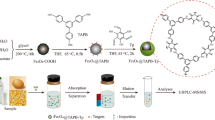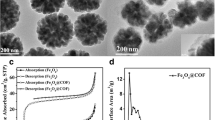Abstract
Zeolite imidazole framework-based boronic acid-functionalized metal-organic frameworks (ZIF-67@PDA@BA-Zr-MOFs) were developed as an adsorbent for solid phase extraction (SPE) of luteolin (LTL) from peanut shell samples. Herein, ZIF-67 as a support matrix, polydopamine (PDA) as a coating to introduce amino and hydroxyl groups on the matrix surface to fix metal-organic frameworks (MOFs), zirconium tetrachloride (ZrCl4) as a precursor, terephthalic acid (TPA), and 3-carboxyphenylboronic acid (3-CPBA) as the mutual organic building blocks, and 3-CPBA was also a boronate affinity functional monomer. The effects of synthesis conditions, SPE conditions, selectivity, competitivity, reproducibility, and reusability were evaluated in detail. Under the optimal conditions, the maximum adsorption capacity is 71.4 mg g−1. The utility of ZIF-67@PDA@BA-Zr-MOFs as an adsorbent for SPE of LTL is supported by the presence of the abundant pore structure, as well as the boronate affinity sites facilitated the rapid binding of the adsorbent to the template. The concentration of the extracted LTL was determined by the high-performance liquid chromatography-ultraviolet (HPLC-UV), with calibration plots being linear in the concentration range 0.05–100 mg L−1 and a limit of detection (LOD) of 0.035 mg L−1. The method was applied to determine the LTL in peanut shell samples and recovered the target analyte in the range 85.6% to 99.2% (the standard deviations are less than 3.3%, n = 3). In addition, we incorporated boronate affinity and MOFs material into an SPE system to provide a promising strategy to detect other cis-diol-containing analytes in the complex matrix.
Graphical abstract





Similar content being viewed by others
References
Guo BL, Tong YK, Zhang BY, Tian MM (2021) Double affinity based molecularly imprinted polymers for selective extraction of luteolin: a combination of synergistic metal chelating and boronate affinity. Microchem J 160:105670
Dean LL (2020) Extracts of peanut skins as a source of bioactive compounds: methodology and applications. Appl Sci 10:8546
Pan LS, Zhao XY, Zeng S, Xiang FY, Zhao GG, Li YF (2019) Extraction of luteolin from peanut shells by a hydrophilic ionic liquid-based microwave-assisted method. Chemistry Select 4:13589–13595
Pan JM, Huang XB, Gao L, Peng YX, Liu SC, Gu RX (2017) Experimental investigation of a natural favonoid adsorption on macroporous polymers with intrinsic cis-diol moieties recognition function: Static and dynamic methods. Chem Eng J 312:263–274
Cao XX, Wang M, Sun LL, Ren XL, Pei GS (2018) Preferential adsorption of flavonoids from peanut shell by amino-modified Fe3O4 nanoparticles (MNP-NH2). J Sci Food Agric 98:3588–3594
Jia Q, Ma Y, Peng YX, Liu YH, Zhang WL (2018) Selective recognition and separation of luteolin based on the molecular imprinted hollow SnO2 and boronate affinity. Chem Eng J 342:293–303
Bai X, Liu SC, Liu JX, Ma Y, Zhang WL, Pan JM (2018) Specific uptake luteolin by boronate affinity-based single-hole hollow imprinted polymers sealed in dialysis bags. Chem Eng J 353:911–919
Liu SC, Pan JM, Zhu HJ, Pan GQ, Qiu FX, Meng MJ, Yao JT, Yuan D (2016) Graphene oxide based molecularly imprinted polymers with double recognition abilities: the combination of covalent boronic acid and traditional non-covalent monomers. Chem Eng J 290:220–231
Raabová H, Erben J, Chvojka J, Solich P, Švec F, Šatínský D (2020) The role of pKa, log P of analytes, and protein matrix in solid-phase extraction using native and coated nanofibrous and microfibrous polymers prepared via meltblowing and combined meltblowing/electrospinning technologies. J Chromatogr A 1631:461580
Ali MM, Hussain D, Xu B, Sun TQ, Du ZX (2020) Diethylenetriamine assisted functionalization of boronic acid on poly GMA-MAA-DVB for selective enrichment of glycoproteins and glycopeptides. Talanta 219:121178
Deng YN, Gao Q, Ma J, Wang CZ, Wei YM (2018) Preparation of a boronate affinity material with ultrahigh binding capacity for cis-diols by grafting polymer brush from polydopamine-coated magnetized graphene oxide. Microchim Acta 185:189
Ali MM, Hussain D, Tang Y, Sun XC, Shen ZC, Zhang FX, Du ZX (2021) Boronoisophthalic acid as a novel affinity ligand for the selective capture and release of glycoproteins near physiological pH. Talanta 225:121896
Li DJ, Xia HJ, Wang L (2018) Branched polyethyleneimine-assisted boronic acid-functionalized silica nanoparticles for the selective enrichment of trace glycoproteins. Talanta 184:235–243
Yao JT, Ma Y, Liu JX, Liu SC, Pan JM (2019) Janus-like boronate affinity magnetic molecularly imprinted nanobottles for specific adsorption and fast separation of luteolin. Chem Eng J 356:436–444
Muhammad SS, Blagojce J, Parul M, Batool F, Dilshad H, Fahmida J, Muhammad NA, Tara LP, Muhammad NH (2020) Glycosylation heterogeneity and low abundant serum glycoproteins MS analysis by boronic acid immobilized Fe3O4@1,2-Epoxy-5-Hexene/DVB magnetic core shell nanoparticles. Microchem J 159:105351
Zhang RQ, Wang Z, Wang TF, Su P, Yang Y (2020) Boronic acid-decorated metal-organic frameworks modified via a mixed-ligand strategy for the selective enrichment of cis-diol containing nucleosides. Anal Chim Acta 1106:42–51
Tan W, Chen T, Liu WR, Ye FG, Zhao SL (2021) Design and fabrication of boric acid functionalized hierarchical porous metal-organic frameworks for specific removal of cis-diol-containing compounds from aqueous solution. Appl Surf Sci 535:147714
Bie ZJ, Huang AL, Zhang YN, Chen Y (2019) Boronate affinity Metal-Organic frameworks for highly efficient cis-diol molecules in-situ enrichment and surface-assisted laser desorption/ionization mass spectrometric detection. Anal Chim Acta 1065:40–48
Ibrahim AO, Adegoke KA, Adegoke RO, AbdulWahab YA, Oyelami VB, Adesina MO (2021) Adsorptive removal of different pollutants using metal-organic framework adsorbents. J Mol Liq 333:115593
Wang C, Lin G, Zhao JL, Wang SX, Zhang LB, Xi YH, Li XT, Ying Y (2020) Highly selective recovery of Au(III) from wastewater by thioctic acid modified Zr-MOF: experiment and DFT calculation. Chem Eng J 380:122511
Abrar M, Dilshad H, Batool F, Muhammad A, Muhammad NA, Muhammad NH (2019) Gallic acid functionalized UiO-66 for the recovery of ribosylated metabolites from human urine samples. Talanta 201:23–32
Khalil A, Muhammad AN, Ahmad KQ, Ejaz H, Tayyaba N, Muhammad SJ, Syed SAS, Muhammad KT, Shahid H, Naseem AK, Habib-ur-Rehman S, Muhammad A (2020) Engineering of Zirconium based metal-organic frameworks (Zr-MOFs) as efficient adsorbents. Mater Sci Eng B Adv 262:114766
Zhu XY, Gu JL, Zhu JY, Li YS, Zhao LM, Shi JL (2015) Metal-organic frameworks with boronic acid suspended and their implication for cis-diol moieties binding. Adv Funct Mater 25:3847–3854
Xie YQ, Liu QJ, Li Y, Deng CH (2018) Core-shell structured magnetic metal-organic framework composites for highly selective detection of N-glycopeptides based on boronic acid affinity chromatography. J Chromatogr A 1540:87–93
Liu SC, Ma Y, Gao L, Pan JM (2018) pH-responsive magnetic metal-organic framework nanocomposite: a smart porous adsorbent for highly specific enrichment of cis-diol containing luteolin. Chem Eng J 341:198–207
Pan YN, Guo XM, Li SS, Liu XY, Zhang HX (2013) Boronate-decorated porous carbon material derived from zinc-based metal-organic framework for enrichment of cis-diol-containing nucleosides. New J Chem 42:2288–2294
Liu SC, Pan JM, Ma Y, Qiu FX, Niu XH, Zhang T, Yang LL (2016) Three-in-one strategy for selective adsorption and effective separation of cis-diol containing luteolin from peanut shell coarse extract using PU/GO/BA-MOF composite. Chem Eng J 306:655–666
Xia BY, Yan Y, Li N, Wu HB, Lou XW(D), Wang X (2016) A metal-organic framework-derived bifunctional oxygen electrocatalyst. Nat Energy 1:15006
Gao ZG, Zhang JQ, Zhang SJ, Lan D, Zhao ZH, Kou KC (2020) Strategies for electromagnetic wave absorbers derived from zeolite imidazole framework (ZIF-67) with ferrocene containing polymers. Polymer 202:122679
Yu ZB, Qian L, Zhong T, Ran Q, Huang J, Hou YP, Li FY, Li MJ, Sun QQ, Zhang HQ (2020) Enhanced visible light photocatalytic activity of CdS through controllable self-assembly compositing with ZIF-67. Mol Catal 485:110797
Martínez-Pérez-Cejuela H, Mompó-Roselló Ó, Crespí-Sánchez N, Cabello CP, Catalá-Icardo M, Simó-Alfonso EF, Herrero-Martínez JM (1631) Determination of benzomercaptans in environmental complex samples by combining zeolitic imidazolate framework-8-based solid-phase extraction and high-performance liquid chromatography with UV detection. J Chromatogr A 2020:461580
Li YF, Yan XL, Hu XY, Feng R, Zhou M (2019) Trace pyrolyzed ZIF-67 loaded activated carbon pellets for enhanced adsorption and catalytic degradation of Rhodamine B in water. Chem Eng J 375:122003
Tong YK, Zhang BY, Guo BL, Wu WJ, Jin YX, Geng F, Tian MM (1637) Gallic acid-affinity molecularly imprinted polymer adsorbent for capture of cis-diol containing Luteolin prior to determination by high performance liquid chromatography. J Chromatogr A 2021:461829
Gao D, Yang FQ, Xia ZN, Zhang QH (2016) Molecularly imprinted polymer for the selective extraction of luteolin from Chrysanthemum morifolium Ramat. J Sep Sci 39:2885–3092
Wang N, Zhou XS, Cui B (2019) Synthesis of a polymeric imidazolium-embedded octadecyl ionic liquid-grafted silica sorbent for extraction of flavonoids. J Chromatogr A 1606:460376
Wang ZB, Sun R, Wang YP, Li N, Lei L, Yang X, Yu AM, Qiu FP, Zhang HQ (2014) Determination of phenolic acids and flavonoids in raw propolis by silica-supported ionic liquid-based matrix solid phase dispersion extraction high performance liquid chromatography-diode array detection. J Chromatogr B 969:205–212
Hadjmohammadi M, Karimiyan H, Sharifi V (2013) Hollow fibre-based liquid phase microextraction combined with high-performance liquid chromatography for the analysis of flavonoids in Echinophora platyloba DC. and Mentha piperita. Food Chem 141:731–735
Acknowledgements
This work was supported by the University Nursing Program for Young Scholars with Creative Talents in Heilongjiang Province, China (No. UNPYSCT-2018179).
Author information
Authors and Affiliations
Corresponding author
Ethics declarations
Conflict of interest
The authors declare that they have no competing interests.
Additional information
Publisher’s note
Springer Nature remains neutral with regard to jurisdictional claims in published maps and institutional affiliations.
Supplementary Information
ESM 1
(DOC 3.46 mb)
Rights and permissions
About this article
Cite this article
Guo, B., Chen, X., He, J. et al. ZIF-based boronic acid functionalized metal-organic frameworks for the enrichment of cis-diol-containing luteolin from food samples prior to HPLC. Microchim Acta 188, 229 (2021). https://doi.org/10.1007/s00604-021-04881-3
Received:
Accepted:
Published:
DOI: https://doi.org/10.1007/s00604-021-04881-3




